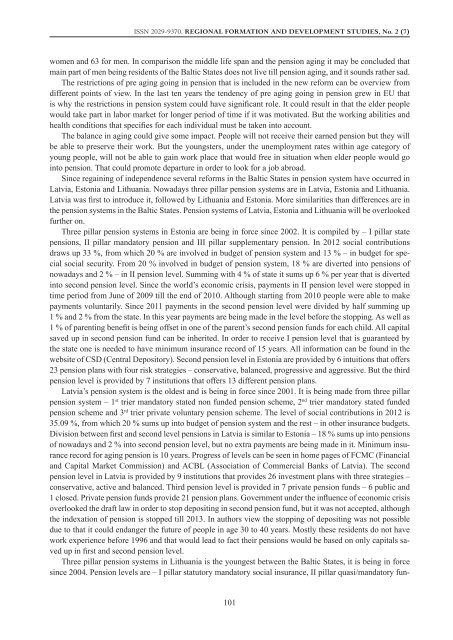regional formation and development studies - KlaipÄdos universitetas
regional formation and development studies - KlaipÄdos universitetas
regional formation and development studies - KlaipÄdos universitetas
Create successful ePaper yourself
Turn your PDF publications into a flip-book with our unique Google optimized e-Paper software.
ISSN 2029-9370. Regional Formation <strong>and</strong> Development Studies, No. 2 (7)<br />
women <strong>and</strong> 63 for men. In comparison the middle life span <strong>and</strong> the pension aging it may be concluded that<br />
main part of men being residents of the Baltic States does not live till pension aging, <strong>and</strong> it sounds rather sad.<br />
The restrictions of pre aging going in pension that is included in the new reform can be overview from<br />
different points of view. In the last ten years the tendency of pre aging going in pension grew in EU that<br />
is why the restrictions in pension system could have significant role. It could result in that the elder people<br />
would take part in labor market for longer period of time if it was motivated. But the working abilities <strong>and</strong><br />
health conditions that specifies for each individual must be taken into account.<br />
The balance in aging could give some impact. People will not receive their earned pension but they will<br />
be able to preserve their work. But the youngsters, under the unemployment rates within age category of<br />
young people, will not be able to gain work place that would free in situation when elder people would go<br />
into pension. That could promote departure in order to look for a job abroad.<br />
Since regaining of independence several reforms in the Baltic States in pension system have occurred in<br />
Latvia, Estonia <strong>and</strong> Lithuania. Nowadays three pillar pension systems are in Latvia, Estonia <strong>and</strong> Lithuania.<br />
Latvia was first to introduce it, followed by Lithuania <strong>and</strong> Estonia. More similarities than differences are in<br />
the pension systems in the Baltic States. Pension systems of Latvia, Estonia <strong>and</strong> Lithuania will be overlooked<br />
further on.<br />
Three pillar pension systems in Estonia are being in force since 2002. It is compiled by – I pillar state<br />
pensions, II pillar m<strong>and</strong>atory pension <strong>and</strong> III pillar supplementary pension. In 2012 social contributions<br />
draws up 33 %, from which 20 % are involved in budget of pension system <strong>and</strong> 13 % – in budget for special<br />
social security. From 20 % involved in budget of pension system, 18 % are diverted into pensions of<br />
nowadays <strong>and</strong> 2 % – in II pension level. Summing with 4 % of state it sums up 6 % per year that is diverted<br />
into second pension level. Since the world’s economic crisis, payments in II pension level were stopped in<br />
time period from June of 2009 till the end of 2010. Although starting from 2010 people were able to make<br />
payments voluntarily. Since 2011 payments in the second pension level were divided by half summing up<br />
1 % <strong>and</strong> 2 % from the state. In this year payments are being made in the level before the stopping. As well as<br />
1 % of parenting benefit is being offset in one of the parent’s second pension funds for each child. All capital<br />
saved up in second pension fund can be inherited. In order to receive I pension level that is guaranteed by<br />
the state one is needed to have minimum insurance record of 15 years. All in<strong>formation</strong> can be found in the<br />
website of CSD (Central Depository). Second pension level in Estonia are provided by 6 intuitions that offers<br />
23 pension plans with four risk strategies – conservative, balanced, progressive <strong>and</strong> aggressive. But the third<br />
pension level is provided by 7 institutions that offers 13 different pension plans.<br />
Latvia’s pension system is the oldest <strong>and</strong> is being in force since 2001. It is being made from three pillar<br />
pension system – 1 st trier m<strong>and</strong>atory stated non funded pension scheme, 2 nd trier m<strong>and</strong>atory stated funded<br />
pension scheme <strong>and</strong> 3 rd trier private voluntary pension scheme. The level of social contributions in 2012 is<br />
35.09 %, from which 20 % sums up into budget of pension system <strong>and</strong> the rest – in other insurance budgets.<br />
Division between first <strong>and</strong> second level pensions in Latvia is similar to Estonia – 18 % sums up into pensions<br />
of nowadays <strong>and</strong> 2 % into second pension level, but no extra payments are being made in it. Minimum insurance<br />
record for aging pension is 10 years. Progress of levels can be seen in home pages of FCMC (Financial<br />
<strong>and</strong> Capital Market Commission) <strong>and</strong> ACBL (Association of Commercial Banks of Latvia). The second<br />
pension level in Latvia is provided by 9 institutions that provides 26 investment plans with three strategies –<br />
conservative, active <strong>and</strong> balanced. Third pension level is provided in 7 private pension funds – 6 public <strong>and</strong><br />
1 closed. Private pension funds provide 21 pension plans. Government under the influence of economic crisis<br />
overlooked the draft law in order to stop depositing in second pension fund, but it was not accepted, although<br />
the indexation of pension is stopped till 2013. In authors view the stopping of depositing was not possible<br />
due to that it could endanger the future of people in age 30 to 40 years. Mostly these residents do not have<br />
work experience before 1996 <strong>and</strong> that would lead to fact their pensions would be based on only capitals saved<br />
up in first <strong>and</strong> second pension level.<br />
Three pillar pension systems in Lithuania is the youngest between the Baltic States, it is being in force<br />
since 2004. Pension levels are – I pillar statutory m<strong>and</strong>atory social insurance, II pillar quasi/m<strong>and</strong>atory fun-<br />
101

















